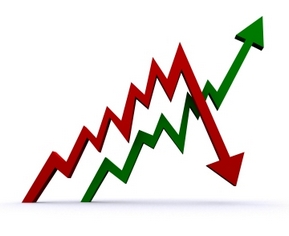Are these hedge funds on to something and should you follow?
Yes and maybe. While the majority of the short positions were most likely put up as a hedge against declining markets, there is a growing group of short sellers that are going after the market on a net profit basis.
As per our mathematical and timing work (bear market of 2014-2017), such short sellers are positioning themselves in a proper way. Yet, this will not be an easy bear market to work with. Not even close. If I had to compare, the Dow will oscillate in a very similar fashion to the bear market that had occurred on the Dow between 2000 top and 2003 bottom. Or….a lot of highly volatile ups and downs that are guaranteed to drive both bulls and bears up the wall.
If you can operate in such an environment it might be a good idea to consider going short as soon as the bear market starts. If you would be interested in learning exactly when the bear market will start (to the day) and its subsequent internal composition, please CLICK HERE.
Did you enjoy this article? If so, please share our blog with your friends as we try to get traction. Gratitude!!!
Click here to subscribe to my mailing list
Hedge Funds Are Shorting Small Caps…..Should You? Google
Bloomberg Writes: Hedge Funds Short Small Caps Most Since ’04 Russell Falls
Money managers are turning on stocks that have delivered the best returns during the bull market: small caps.
Large speculators such as hedge funds are betting $2.8 billion this month that the Russell 2000 Index will fall. That’s the most since 2012 and the highest versus average levels since 2004, according to data compiled by Bloomberg and Bank of America Corp. The about-face from a year of bullish wagers coincides with lackluster performance. The gauge of the smallest companies stands 7.1 percent below its 2014 high, trailing the recovery that has put the Standard & Poor’s 500 Index within 1.5 percent of a record.
Companies from KapStone Paper & Packaging Corp. to Cardtronics Inc. have climbed 20 times more than the S&P 500 since March 2009 amid faster sales and earnings growth. That’s also made them expensive. Valuations in theRussell 2000 rose above levels from the 1990s technology bubble. While small-cap shares are usually the first to benefit when economic growth picks up, the selloff reflects a loss of faith by professional investors in the five-year equity rally.
“Small-cap stocks are the most expensive I’ve ever seen them, and I’ve been doing this for 20 years,” Eric Cinnamond, manager of the $724 million Aston/River Road Independent Value Fund, said in an interview from Louisville, Kentucky. “There’s a lot of junk in the Russell 2000. If you’re a hedge fund, you’re seeing people starting to sell things like Netflix and Facebook and the biotechs, and a nice way to sell risk is to sell the Russell 2000.”
Biggest Speculators
The biggest speculators have increased short sales and bought hedges in most stocks as technology companies led a decline that erased $1 billion from American share values between April 2 and April 12. Traders including hedge funds cut holdings of Nasdaq 100 Index futures and turned bearish on the S&P 500 in the week ended April 15, according to data from the Commodity Futures Trading Commission.
In futures on the Russell 2000, whose constituents have an average market capitalization of about $1 billion, large speculators added to bearish bets that had reached $2.5 billion the previous week. Selling a futures contract is similar to a short sale, where a trader borrows and sells a security in the hope of profiting from a decline.
“It suggests a market that has become defensive,” Sid Mokhtari, a technical research strategist at CIBC World Markets Inc. in Toronto, said by phone on April 23. “We’ve seen defensive posturing in the market. We somehow have lost momentum in the small-cap space.”
Highest Valuation
The Russell 2000 last month reached a valuation of 10.8 times its members’ annual earnings before interest, taxes, depreciation and amortization, according to data compiled by Bloomberg. That was the highest since at least 1995 and compares with an average weekly ratio of 7.7 times Ebitda, the data show. The valuation was at 10.2 at the end of last week.
The Russell 1000 Index for larger stocks such as Apple Inc. and Exxon Mobil Corp. trades at 8.7 times Ebitda, close to the highest since 2001. The small-cap index carries an 18 percent premium relative to the large-cap measure, after reaching 23 percent in March and climbing to 26 percent in September, according to the data.
Russell 2000 futures gained 0.4 percent at 8:55 a.m. in London today, while S&P 500 contracts advanced 0.3 percent.
Embedded Premium
“If you look at the premium embedded in small caps through history, it tends to max out at 25 percent before reverting,” said Dan Morris, who helps oversee $569 billion as global investment strategist at TIAA-CREF Asset Management in New York. “We are still at fairly high levels, so it is not a good entry point for small caps versus large caps.”
Smaller companies have rallied as their earnings almost quadrupled between 2008 and 2013, according to data compiled by Bloomberg. Profits in the S&P 500 have gained 86 percent in the period, the data show.
“You get to a point where the valuation in small caps can get so high relative to large caps that the growth advantage is fully priced in,” Kevin Caron, a market strategist at Stifel Nicolaus & Co. in Florham Park, New Jersey, said by phone on April 23. His company oversees about $160 billion. “We may be pushing up against that limit.”
KapStone, the Northbrook, Illinois-based maker of paper and bags, has fallen 7.1 percent in 2014 after rising 40-fold between March 2009 and the end of 2013. The company boosted sales by an annual average of 28 percent during those years, data compiled by Bloomberg show.
Teller Machines
Cardtronics, which operates a network of automated teller machines, has fallen 24 percent this year after surging 41-fold from 2009 to 2013. Lakewood Capital Management LP said in a letter to investors on April 23 that it has started a short position in the Houston-based company.
Weakness in small-cap stocks is sometimes viewed as an augury for the broader market by analysts who consider the companies a harbinger for the economy.
During this month’s market retreat, the Russell 2000 fell almost twice as fast as the S&P 500 and remains 7.1 percent away from its March high. Other gauges considered bellwethers for the market, such as the Dow Jones Transportation Average and the Morgan Stanley Cyclical index, reached new records last week.
Professional investors are already bearing the brunt of selling in larger stocks. In the S&P 500, where companies have an average market value of $35.9 billion, shares with the highest levels of hedge-fund ownership fell twice as fast as the rest of the market during the week ended April 11, when declines reached the most in almost two years.
Missing Out
At the same time, hedge funds missed out on the most profitable short-sale opportunities. Shares borrowed and sold on expectations of a decline amounted to 0.2 percent of Facebook Inc.’s outstanding stock and 1 percent of Netflix Inc., down from 15 percent two years ago, according to data compiled by Bloomberg and Markit. Both stocks lost more than 20 percent from their highs in March.
Small caps were disproportionately punished in April due to disappointing economic data and will rebound as lending conditions and growth improve, said James Butterfill, head of global equity strategy at Coutts & Co. in London. Citigroup Inc.’s U.S. Economic Surprise Index, which drops when releases miss forecasts, fell on April 7 to the lowest since July 2012 as bad weather hurt data.
Longer Term
“Longer term, if you look at their fundamentals, aside from valuations, it suggests that small caps should continue to outperform,” Butterfill, who helps oversee $50 billion, said by phone on April 25. “There is a challenge in valuations, but people are willing to pay for that growth.”
Economists forecast the U.S. expansion will accelerate from what has been the slowest recovery since World War II. Gross domestic product will grow 2.7 percent this year and 3 percent in 2015, according to the median estimate in a Bloomberg survey.
Small caps have led the bull market as three rounds of monetary stimulus from the Federal Reserve drove investors into riskier assets. The Russell 2000 has returned 28 percent a year since March 2009, compared with a 24 percent increase in the S&P 500, data compiled by Bloomberg show.
The outperformance continued through April 2, even as earnings growth trailed large caps. Profitsfrom Russell 2000 companies shrank for a third quarter in the first three months of 2014, compared with average growth of 7.8 percent in S&P 500 stocks during that period. While thelarger companies exceeded analysts’ earnings estimates by a combined 5.8 percent in the first quarter, smaller firms beat by 0.3 percent, according to data compiled by Bloomberg.
Individual Stocks
Speculators have bigger bets against individual small caps too. Russell 2000 companies have on average 4.2 percent of their stock on loan, an indication of short-sellers’ activity, according to Markit data on Bloomberg. The average short-interest position on S&P 500 shares is 2.1 percent.
The short bets in Russell 2000 futures marked the biggest negative deviation from a mean since at least 2004, relative to historical positioning, according to data through April 15 compiled by Bank of America.
The recent performance of the smallest companies is indicative of broader concerns, according toUri Landesman, the president of New York-based Platinum Partners LLP.
“Small caps are in a riskier area of the market that hasn’t quite participated in this rebound, and they’re leading what will be a fairly significant correction in the market,” Landesman, who helps oversee $1.3 billion, said in an April 23 phone interview. “They aren’t going to recover right now. It’s a sign of some danger to come.”




